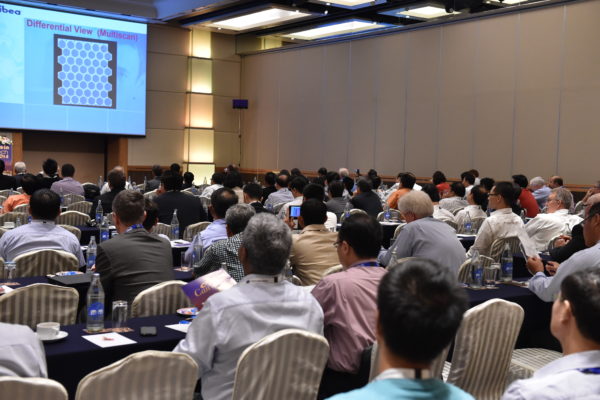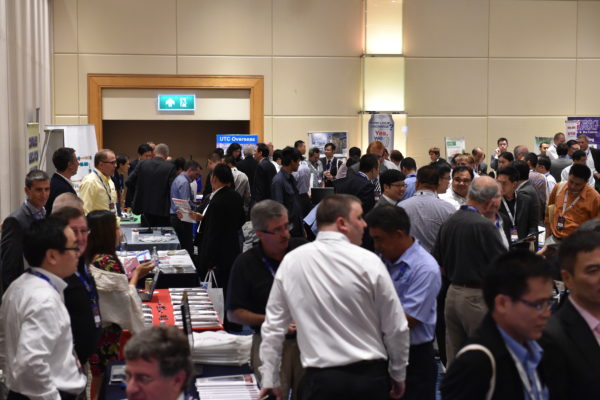Asia CanTech 2014 Review

Asia CanTech 2014, the premier conference for the metal packaging industry, took place in Bangkok in October of this year. Here are the highlights.
27-29 October 2014 saw the convergence of the industry’s best and finest at the Royal Orchid Sheraton Hotel & Towers in Bangkok, Thailand.
The event was the 12th of its kind and saw a record number of delegates and exhibitors in attendance, with some 370+ gathering at the venue to take in the many and varied presentations scheduled over the three days, as well as over 60 table top exhibition stands.
Day one saw registration open at 12.00, with the exhibition space opening at 14.00 local time. The bustle in the room was immediately apparent, as conversations were struck up over existing equipment and innovations alike. The industry, although large, sees many of the same faces around the world, and many new ones too, and it is always our aim to facilitate both ongoing and new conversations between can makers and suppliers.

The evening was testament to this as the cocktail reception and networking dinner began at 19.00 on the warm terrace by the river. Not even the somewhat expected heavy rain would dampen the mood, and again the conversation flowed through until late into the evening.
Day two, following a few words of welcome from Conference Director Neil McRitchie, opened with a presentation from keynote speaker Craig Jones, sector director for beverage cans (AMEA) at Rexam. Craig noted that Rexam produced 62bn cans in 2013 and that “while we may not be associated with James Bond technologies, make no mistake, we are about quality.”
He went on to highlight the importance of sustainability within the metal packaging industry and commented that Rexam is judged not just on financial performance but also on its business practices. The company joined the sustainability benchmark in 2013 and, Craig told us, will be focusing heavily on delivering and exceeding their targets going forward.
Following a presentation by Applied Vision’s Jeff Hartung on the importance of early detection of flaws, during which he outlined the highly efficient DecoMaster Color Blanket Inspection system, Michael Tshol of SPG Prints looked at a variety of packaging options available in the market and explained why, in his opinion, the two-piece can in the best all-round option. “In general, plastic waste has a bad name,” he said. “Bottles are handy, and in Europe you can return them to the store to get your deposit back, but transportation costs are high.”
After the networking coffee break, Larry Lau of Sencon addressed the delegation with his presentation on the critical importance of measuring systems when it comes to process control. He looked closes at gauges, and how their performances must improve as tolerances tighten. He remarked: “The more capable the gauge, the better decisions we can make.”
Larry was followed by Siegfried Christ of Mall//Herlan, who highlighted trends in the packaging sector, even going so far as to call certain innovations ‘sexy.’ Siegfried looked at the flexibility his company can offer its customers and how they adapt to their needs and requirements. “We usually receive an idea from a customer and we then develop this from start to finish in-house,” he said.
It was interesting to hear his positive views on D&I aluminium bottles, remarking as he did on their ability to combine the premium of glass with the convenience of the can.
Xiamen Baofeng were also in attendance, and David Williamson gave us an update on the company’s growth in recent years. Today they have seven shell presses with a capacity in 2014 of 17bn. “You can’t call yourself world class without delivering world class quality,” he said. “We react to customer requirements and re-tool to respond to demand.” The company is now fully accredited by Coca-Cola, Pepsi and Heineken and has sales exceeding 1bn ends per month and rising.

Another can maker, ORG Packaging, was represented by Shunying Yang. The company was the first to use polymer laminated steel in China and has a philosophy that encapsulates innovation, green values and safety consciousness. The firm is looking to expand capacity in order to meet market demand and will look to establish several overseas agents in the very near future.
Of the many and varied speakers present at the event, a high number represented the field of inspection technology. Greg Frisby of Sensory Analytics gave us a detailed insight of the Specmatrix system and how it can help to significantly reduce costs, and Mark Mohn of Prime Controls spoke of the importance of detecting such things as pinhole defects and double ends using sensing and control technology.
Thomas Duve of CMC-Kuhnke rounded off the presentations for day one before the Technical Forum, again looking at the benefits of quality control. The company has over 250 active products in the can industry, with equipment that apparently allows customers to regain control of their processes.
Finally, Mike Raderchak and Greg Williams of Stolle Machinery opened the technical forum. The presentations looked at what they called ‘The End Game’ and provided an overview on problem solving when it comes to end manufacture.
It was interesting to learn about how savings can be made without compromising on quality and there is still room for this according to Mike and Greg. From a cost perspective, 89 per cent of the cost of a shell lies in the metal, so by reducing the metal it stands to reason that you can save money. Of course, lightweighting can lead to issues in manufacture. For example, reducing the centre panel and the gauge can cause seaming issues and microwrinkles, which apparently can be alleviated with the use of Enhanced Rotary Curling.
Day two also saw the Asia CanTech Awards Gala Dinner. This year the categories were: Aerosols, Beverage two-piece, Beverage three-piece, Decorative/Speciality, Ends/Caps/Closures, Food 2=two-piece, Food three-piece, General Line and Innovation. Not forgetting, of course, the Supreme Can Award.
The winners were as follows:
Supreme Award Winner:
Swan Industries – Zola Coco Espresso can
Category winners:
Two-piece Beverage
STI-Can – Delster Can
Decorative/Speciality
Benjamit Packaging – Moccona Trio Box
Aerosols
Swan Industries – Glade Can
Three-piece Food
Sinar Djaja Can – Royal Gdansk cookie tin
Three-piece Beverage
Swan Industries – Zola Coco Espresso can
General Line
Tinpak Ltd – Vintage Teas Christmas Cheer can
Innovation
Crown Asia Pacific Holdings Ltd – Laminate Pail
Ends, caps & Closures
Sinar Djaja Can – Almithali easy-open end
Day three opened with keynote speaker Thongchai Oranrigsupak from Benjamit Packaging. Thongchai spoke at length about how Thailand aims to be the ‘kitchen of the world’ and the role metal packaging plays on the road to achieving this goal. He looked not only at Benjamit’s business, but also at that of the Thai Can Cluster as a whole, of which he is a senior figurehead.
The morning featured a number of presentations, among which was Hans Hoffman’s of Vision Experts. He spoke of the company’s VE4000+ Metal, which detects everything from hickeys, ink splashes and spots to water and oil drops, smearing and dirt.
“It is very important to find defects early and to stop them,” he said.
Johan Jonkmann of VMI followed, maintaining the already emerged theme of quality checks across the board, from purchasing to production, before Marcus Greenbrook of GEW spoke to us on the topic of UV systems for metal decorating.
“High intensity is key to a UV curing system,” he said. “You can liken it to banging a nail into a piece of wood. You would take a big hammer and hit it once, as opposed to a small hammer and hitting it several times.”
Greg Pickert of Pride Engineering then gave a troubleshooting presentation looking into the problem of split or cracked domes, followed by Bud Patel of Pressco Technology. Bud’s enthusiastic presentation covered 100 per cent inspection and hoe it can become a reality for his customers.
Andrew Truelove gave an overview of CMB Engineering, a stalwart company from our native United Kingdom, before Simon Jennings of International Patents & Brands Corporation delivered a very interesting talk on consumer perception when it comes to beverage cans. The statistics he discussed were very enlightening to say the least.
He commented: “To me, the beverage can is the best single-serve packaging in the world.”
Day three was concluded by Daniel Hilfiker of Pnemofore SpA, who looked at the value of using air compressors and vacuum pumps as opposed to water cooled equipment. He looked in particular at the hot climate versions of his company’s rotary vane compressors and UV series vacuum pumps.
Overall, the trend or theme that emerged over the course of the conference was one of the need to ensure quality across all mediums. From purchasing raw materials, right up to the finished products, each stage has to be as perfect as it can be to ensure 100 per cent customer and consumer satisfaction. Only by observing this mantra of quality can the industry as a whole continue to progress as impressively as it has over the years.
Just when you think you’re as streamlined as it’s possible to be, something new will crop up to convince you otherwise. This is why we put on events such as this – to continue to promote the sharing of ideas and experiences across the industry, and to ensure that you are as up-to-date and current with what’s available to you as you can possibly be.
The presentations given are available (for the most part) on request via events manager Megan Freeman ([email protected]).
On behalf of the team, we would like to thank everyone who attended, exhibited and or gave a presentation in Bangkok. We are incredibly pleased with the event and hope that our goal was achieved – for everybody to come away with something of real use to them and their organisation, be it a deal, a contract, or simply a new business contact.
We look forward to seeing you all again next year.
